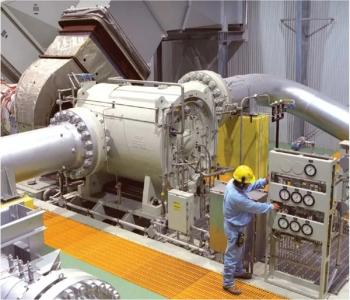
POWERGEN KEYNOTE PREDICTS GAS BOOM
TRENDS INCLUDE: INCREASED COMPRESSED NATURAL GAS, SLOWING ELECTRIC LOAD GROWTH, MORE RENEWABLES AND LOWER COMBINED CYCLE CAPACITY
PowerGen International 2012 in Orlando, Florida, once again attracted record crowds. Over 20,000 attendees and more than 1,300 exhibitors came for an event that now combines PowerGen with the Renewable Energy World and Nuclear Power International conferences.
The opening keynote began with Gordon Gillette, President of both Tampa Electric and Peoples Gas. He looks after a generation fleet of 4,700 MW, comprising three power plants (60% coal, 40% gas), as well as 11,000 miles of natural gas pipelines covering most of Florida.
Gillette outlined trends such as lower customer demand and lower energy consumption per customer. “That equates to 1.3% customer growth per year; and we won’t reach the 2.5% we had prior to 2008 any time soon,” said Gillette. “Customers are becoming greener and there is the slow but steady proliferation of appliances and iPads, which are energy efficient.”
Like most speakers these days, he mentioned the exponential growth of shale gas. By 2035, according to the Energy Information Administration (EIA), 50% of U.S. gas will come from shale. As a result, Peoples Gas is expanding its Compressed Natural Gas (CNG) operations. At a little more than half the price of diesel fuel, CNG currently fuels 450 Peoples Gas trucks.
Environmental forces
Due to continued environmental pressure, ongoing energy policy and lower gas prices, he predicted that all new plants will be natural gas combined cycle, and not coal. He cited more EIA numbers for projected new capacity editions between 2010 and 2035: 60% gas, 5% coal and 27% renewables.
“Natural gas combined cycle will beat Integrated Gasification Combined Cycle for some time to come,” said Gillette. “But there are a few wildcards, such as higher-thanexpected gas prices, perhaps due to regulations or accelerated LNG export, or due to an accelerated federal energy policy.”
Jon Wellinghoff, Chairman of the Federal Energy Regulatory Commission (FERC), used an analogy from the movie “Die Hard,” where Bruce Willis plays the policeman, John McClane, who continually thwarts the evil mastermind, Hans Gruber. “Three elements at play will prove to be as disruptive as John McClane was to Hans Gruber,” said Wellinghoff: Utilities can no longer depend on making money from additional sales because of slowing of load growth nationwide; consumers will have control of usage to the grid operator or utility (as a result, demand response could rise 20% by 2020); and solar installations will multiply, driven by an increase in natural disasters. “The FERC is working to accelerate these disruptive elements as they push for more efficiency which will lower costs for consumers and add value.”
Next up, Jim Ferland, President and CEO of Babcock & Wilcox, covered mega trends affecting the power market. According to EIA figures for 2010, U.S. coal held a 46% share of generation, with gas at 23% and renewables at 11%. By 2035, coal’s share will be at 32%, gas at 26% and renewables at 24%. Worldwide, gas will only grow from 22% in 2010 to 23% by 2035, with coal dropping from 40% to 32%, and renewables surging from 20% to 31%. Ferland stressed power diversity. “. . . it’s best not to put all your eggs in one basket,” he said.
In the 25-year period covered in the EIA study, electricity production jumps by 71% worldwide. During that period, gas increases its share of electricity produced from 22% to 23%. But even bigger gains are scheduled for renewables. EIA estimates that renewables will mushroom from 20% to 31% by 2035. That colossal leap will reap side rewards for gas generation. “Gas works better with wind and solar variability than coal or nuclear,” said Ferland.
Although the U.S. nuclear market will remain flat, big adopters, such as India and China will take nuclear from 400 GW to 570 GW. Similarly, those emerging markets will install enough coal to more than offset declines in Europe; and U.S. coal will jump from 1,500 GW to 2,300 GW in 2035. “The U.S. will still have 257 GW of coal by 2035, which means lots of aftermarket services and environmental upgrades for aging coal plants that remain,” said Ferland. With a new 2,000 MW plant costing about $2.5 billion for gas, $6 billion for coal and $12.1 billion for nuclear, Ferland believes the big Asian utilities will be better able to finance the initial costs of coal and nuclear.
He ended with small nuclear reactors — available in 45 MW to 225 MW modules — which he believes will not be available for five to ten years. “They should be able to load follow so they can compete with gas for a renewable heavy grid,” said Ferland. “But they won’t be as quick as gas.”
Betting on gas
Paul Browning, President and CEO of Thermal Products at GE Power & Water, exuded optimism about the future of natural gas. “The long-term prospects for natural gas have never been more favorable,” he said. “Unconventional gas is a game changer and the U.S. is now the leading producer of natural gas in the world.” But he also expected China to become one of the world’s largest gas-fired generation markets in the near future, and stated that China will have surpassed 10 GW of gas by the end of 2012.
“GE is betting that gas is on a global super-cycle which will last for 25 years or more,” said Browning. This will be aided by rapid industrialization in the Middle East. Saudi Arabia, for example, has such a booming economy that the country is steadily consuming more of its oil resources in the home market. If they continue on that trend, Saudi Arabia will become a net importer by 2038. Expect to see more usage of natural gas for power production in that country as a consequence.
He noted that capacity factors of gas plants in the U.S. have increased from 30% to 80% in recent years due to stronger demand. Looking ahead, though, that will reverse due to the need for more starts and stops to cope with renewable intermittency. And that calls for a new class of machine. With that in mind, GE is beefing up its gas generation portfolio. “Ten new heavy-duty gas turbines are going to be introduced by GE within this decade,” said Browning.
New GE Products
Immediately following the keynote, GE unleashed a snowstorm of press releases covering its thermal product lines, a division that includes heavy-duty gas turbines, steam turbines, generators, controls, air filtration and gasification. It announced several new U.S. orders for its FlexEfficiency 60 technology.
Golden Spread Electric Cooperative, Inc. of Amarillo, Texas, is purchasing three GE 7F 5-series gas turbines for three new power plants making use of the 7F 5-series GT. Browning said this pushed the total orders to $1.5 billion for FlexEfficiency 60 gas turbines. “This is the most successful new product launch in our history,” he added.
Golden Spread will locate these in West Texas or the Texas Panhandle. As an existing GE customer, Golden Spread already has five GE gas turbines. GE’s Measurement & Control business has recently provided upgrades, and GE Power Generation Services is providing an OpFlex Peak Fire upgrade to 7F 3-series units in the fleet. OpFlex Peak Fire was developed to give increased plant flexibility.
Using a 2-on-1 configuration, Flex Efficiency 60 offers 750 MW and can turn down to 108 MW, or ramp at a rate of over 100 MW a minute. GE promises over 61% efficiency. The first plant to operate at that level of efficiency will open in France in 2017.
A new product known as ClearCurrent PRO was also announced at PowerGen. PRO (Predictable Reliable Output) is a gas turbine inlet filter cartridge that raises gas turbine performance while helping to reduce the effects of turbine degradation. GE has been testing the performance of ClearCurrent PRO at a variety of coastal and inland sites for several years.
Lower heat rates
The company reports that inlet systems installed with the product offered improved output, lower heat rates and better overall turbine efficiency compared with earlier technologies. ClearCurrent PRO cartridges are available in galvanized and stainless steel.
“The right filter is vital to ensure performance,” said Browning. ClearCurrent PRO is a hydrophobic filter that takes out small particulate that affects compressor output by up to 2 points in efficiency.”
Fintan Tuffy, General Manager of Fleet Analytics and Performance Management at GE’s Power Generation Services, showcased the 7F Advanced Gas Path (AGP). This upgrade, he said, can boost output by up to 4.8% in combined cycle and 6.5% in simple cycle.
“AGP offers up to a 1% improvement in fuel efficiency and makes it possible to schedule maintenance intervals every 32,000 hours or 900 starts. “It has extended asset and parts life out to as much as 96,000 hours.”
The 100th AGP was sold to Korea Southern Power Company, Ltd. (KOSPO) to upgrade two 7F gas turbines. KOSPO has already installed six AGP systems at its Shinincheon plant to generate 130 MW of additional power. Further AGP customers include Calpine Corporation, Duke Energy, TransCanada Energy Ltd and Iberdrola.
Newsletter
Power your knowledge with the latest in turbine technology, engineering advances, and energy solutions—subscribe to Turbomachinery International today.





